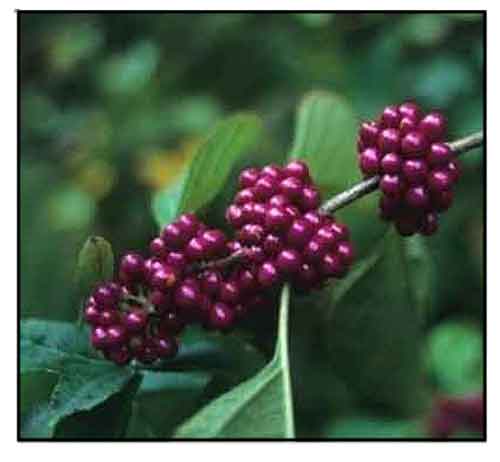
Family • Lamiaceae
Tubang-dalag
Callicarpa erioclona Schauer
BEAUTY BERRY
| Scientific names | Common names |
| Callicarpa cana var. repanda Warb. | Alinau (Mindoro) |
| Callicarpa erioclona Schauer | Kagong (Bag.) |
| Callicarpa erioclona f. glabrescens Moldenke | Malsasambong (Laguna) |
| Callicarpa erioclona var.repanda (Warb.) H.J.Lam | Palis (Tag.) |
| Callicarpa repanda (Warb.) K.Schum. & Warb, | Salingarau (Neg.) |
| Callicarpa subcandida Elmer | Tambalabasi (Tag.) |
| Tigau (Tag.) | |
| Tubang-dalag (Tag.) | |
| Palis, in Dr. E. Quisumbing's compilation, is a local name shared by (1) Callicarpa cana Linn. (2) Callicarpa formosana Rolfe (3) Callicarpa erioclona (4) Abutilon indicum, malbas, palis (Bis). | |
| Tubang-dalag is a local name shared by (1) Tigau, Callicarpa cana (2) Callicarpa erioclona (3) Callicarpa formosana | |
| Callicarpa erioclona Schauer is an accepted species. KEW: Plants of the World Online | |
| Other vernacular names |
| VIETNAMESE: Tu hu long, Tu chau long mem. |
Botany Distribution Properties Studies Availability |
Updated February 2024 / December 2021 / January 2014
![]()
 |
PHOTOS / ILLUSTRATIONS |
| IMAGE SOURCE: / Photo / Callicarpa erioclona Schauer: Berries and Leaves / © Danh luc cay thuoc / Non-commercial use / Click on image or link to go to source page / TRA CUU DUOC LIEU |
| Additional
Sources and Suggested Readings (1) LAMIACEAE Callicarpa / Plants For Use (2) The genus Callicarpa (Lamiaceae) in the Philippines / Gemma L C Bramley / Kew Bulletin, 2013; Vol 68: pp 369-418 / DOI: 10.1007/512225-013-9456-Y (3) Antimicrobial Activities of Malaysian Plant Species / PY Chung, LY Chung, YF Ngeow, SH Goh, Z Imiyabir / Pharmaceutical Biology, 2004, 42(4-5): pp 292-300 / DOI: 10.1080/13880200490511837 (4) Callicarpa / PROSEA Medicinal Plants (5) The genus Callicarpa (Lamiaceae) in the Phillipines / Gemma L C Bramley / Kew Bulletin, 2013; 68(3): pp 369-418 (6) Minor Products of the Philippine Forests / William H Brown (7) Callicarpa erioclona / Kew: Plants of the World Online (8) Environmentally-Friendly Pesticidal Activities of Callicarpa and Karomia Essential Oils from Vietnam and Their Microemulsions / Nguyen Huy Hung, Pham Minh Quan, William N Setzer et al / Chemistry & Biodiversity, 2023; 20(3): e202200210 (9) Acetylcholinesterase Inhibitory Activities of Essential Oils from Vietnamese Traditional Medicinal Plants / Hung N H, Quan P M, Satyal P et al / Molecules (Basel, Switzerland), 2022; 27(20): 7092 / DOI: 10.3390/molecules 27207092 / PMCID: PMC9610647 |
α•(5) |
DOI: It is not uncommon for links on studies/sources to change. Copying and pasting the information on the search window or using the DOI (if available) will often redirect to the new link page. (Citing and Using a (DOI) Digital Object Identifier) |
| List of Understudied Philippine Medicinal Plants |
| New plant names needed The compilation now numbers over 1,300 medicinal plants. While I believe there are hundreds more that can be added to the collection, they are becoming more difficult to find. If you have a plant to suggest for inclusion, native or introduced, please email the info: scientific name (most helpful), local plant name (if known), any known folkloric medicinal use, and, if possible, a photo. Your help will be greatly appreciated. |
α•(5) |
 |

 Gen info
Gen info